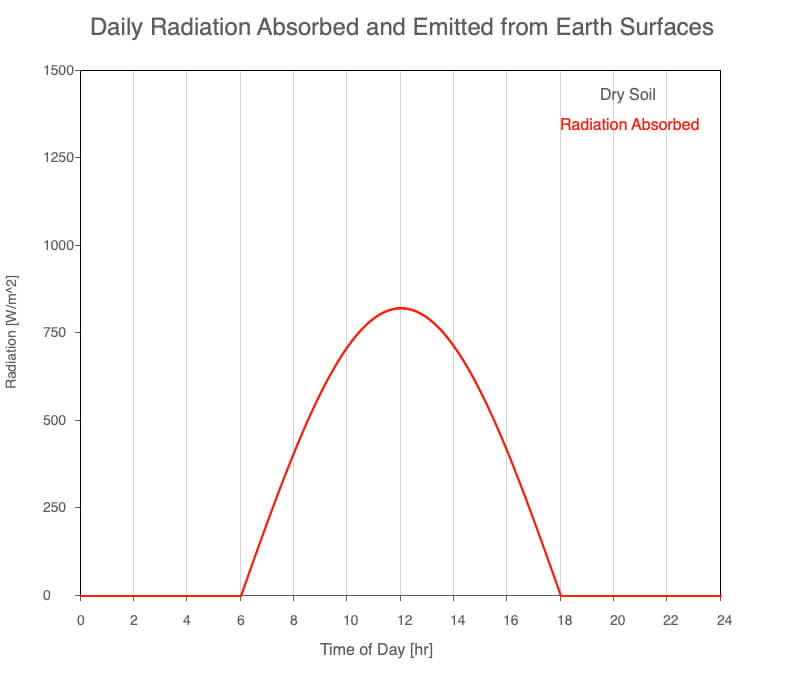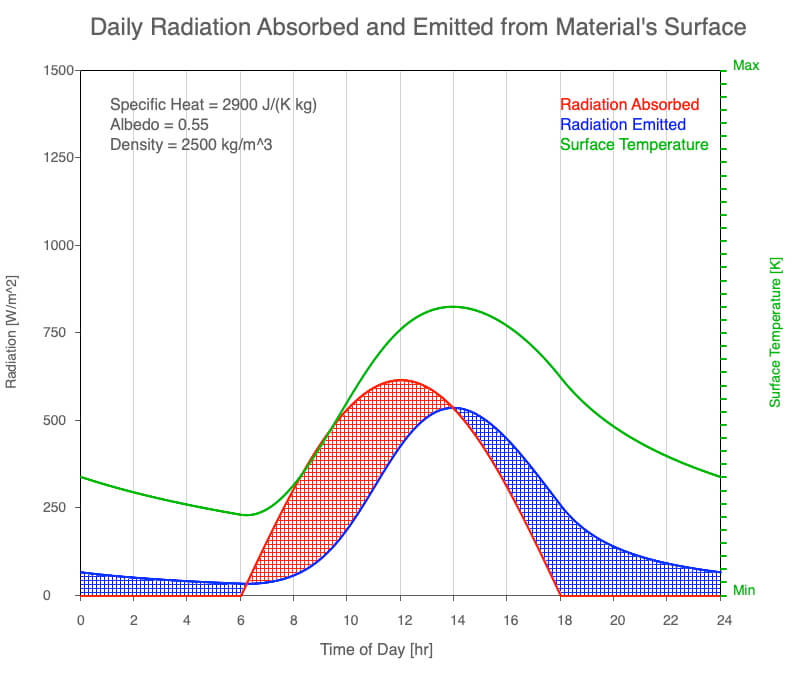Radiation Budgets and Diurnal Heating
The Sun illuminates half the Earth’s spherical surface at any given time, but where the Sun is shining on Earth changes as our planet rotates. The intensity of the sunlight shining on a location is continually changing. At sunrise and sunset, the Sun’s rays are parallel to the ground, so no sunlight is hitting the ground. Halfway between the Sun rising and setting is local noon when the Sun is highest in the sky during the day. This daily incoming radiation pattern is illustrated in this example of the amount of sunlight absorbed by dry soil over 24 hours. The Sun’s apparent movement across the sky creates the diurnal heating cycle on Earth. This night/day heating pattern is quite different from the black fabric experiment described on the previous page.
To allow the data presented on this page to be comparable, this 24-hour pattern of sunlight is the same for all simulations shown in this section. Sunrise is 6 AM, local noon occurs at 12 PM, and sunset is at 6 PM. At local noon, the Sun is directly overhead.
This pattern of solar illumination is not what different locations experience on Earth during the year. To understand and calculate the Sun’s position in the sky at any place on Earth for any day of the year or time of the day, see the Sun-Earth Connection section.
This radiation model is somewhat simplified. A bulk estimate is made for the effects of conduction, advection, convection, and latent heat mechanisms. Because of these simplifications, relate the trends and patterns of the model to Earth processes, not the actual values.

Example of the amount of sunlight being absorbed by dry soil for 24 hours, which mirrors the apparent movement of the Sun across the sky. In this scenario, and all the ones that follow, sunrise occurs at 6 AM and sunset at 6 PM. Halfway between is local noon, when the sunlight shining on the ground is most intense.
Peak Daytime Temperature
Ground temperature increases when there is an energy surplus (shaded red in the following images), where the amount of absorbed radiation is higher than that emitted. How much the ground heats depends on how high the excess is at that moment (the vertical distance between the red and blue lines).
Ground temperatures cool when there is an energy deficit (shaded blue) in which the amount of radiation leaving the ground is higher than that absorbed. The rate of cooling depends on how large the energy deficit is at that moment. Radiative equilibrium occurs when the rates of radiation absorbed and emitted are equal, and since this occurs only briefly, the surface temperature changes continually for 24 hours.
The peak surface temperature does not occur when the Sun is highest in the sky (local noon) but occurs at radiative equilibrium. Since the surface material takes time to warm up, the amount of thermal radiation emitted lags behind the increasing radiation absorbed during the morning hours. When the warmest surface temperature occurs after local noon, the Sun is still relatively high in the sky.
A ground surface will always be in energy deficit at night since there is no incoming solar radiation. There will be continual cooling of the ground at night. Still, since the amount of thermal radiation emitted decreases exponentially as the surface temperature decreases, the rate of ground cooling slows throughout the hours of darkness. For a short period after sunrise, when there is still an energy deficit, the ground continues to cool.

Ground temperature increases when there is an energy surplus (shaded red) and cool when there is an energy deficit (shaded blue).
In this example, the coldest surface temperature is about 15 minutes after sunrise and the warmest is just after 2 PM.
Big Ideas
- The Sun’s apparent movement across the sky creates the diurnal heating cycle on Earth.
- Earth’s rotation and its spherical shape create the continually changing heating pattern we experience each day.
- Radiative equilibrium occurs when the rates of radiation absorbed and emitted are equal. When the rate absorbed is greater than that emitted, there is an energy surplus, and when the rate emitted exceeds that which is absorbed, this is an energy deficit.
- Ground temperature increases when there is an energy surplus and decrease during an energy deficit.
- The peak surface temperature occurs at radiative equilibrium, which happens after local noon, which is when the Sun is highest in the sky.

0 Comments